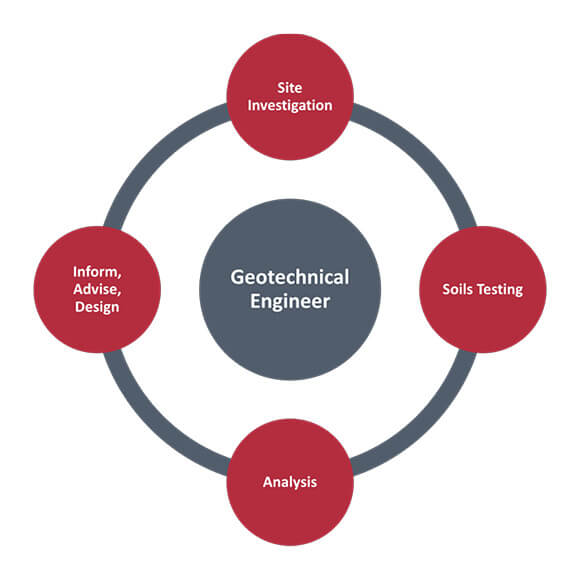The Best Strategy To Use For Geotheta
The Best Strategy To Use For Geotheta
Blog Article
Getting My Geotheta To Work
Table of ContentsSee This Report on GeothetaThe 9-Second Trick For GeothetaSome Known Facts About Geotheta.The Single Strategy To Use For Geotheta
They team up with civil engineers, structural engineers, engineers, and various other specialists to incorporate geotechnical factors to consider right into the total job design and construction process. This needs effective teamwork, sychronisation, and communication to make sure that the geotechnical elements align with the task goals and satisfy regulative needs.Mining & Products Design: Concepts of drilling, infiltration prices, and elements affecting the choice of boring technique. Attributes of nitroglycerins, firing systems and blast patterns. Blowing up strategies in surface area and underground operations. Special blowing up techniques at excavation boundaries. Resonance and sound control. Mechanical and continuous methods to fragmentation, including longwall shearing and fullface boring.
Modelling of fragment and fragment dimension circulations; comminution as a transfer feature. Comminution innovation: crushing, grinding, size category. Integrated evaluation of fragmentation and comminution operations. Supplied by: Mining & Materials Design.
See This Report on Geotheta
Bachelor's degree programs in civil, geotechnical, geological, and ecological engineering usually last 4 years and include general education and learning training courses in English, social scientific research, and the liberal arts, as well as programs in advanced maths, architectural geology, and liquid mineralogy. (https://www.imdb.com/user/ur185987626/?ref_=nv_usr_prof_2)
Geotechnical design involves the assessment of the dirt and rock problems at a specific site, and their implications for the development of that website. As many frameworks depend on the ground for support, it is without surprise that a thorough understanding of the ground conditions, and the viability of foundation systems, are crucial to the long-lasting stability and efficiency of the building or framework.
Being experts in the examination of geological developments and ground practices, geotechnical designers perform scientific examinations and screening to understand the impact these geological formations may have on the design and construction of building, civil and framework tasks. This proficiency is essential for the design and construction of buildings, roads, tunnels, dams, bridges, and water supply and sewage systems.
The geotechnical team at Douglas Allies regularly consult with engineers, design engineers, programmers, and builders to make suggestions on style and advancement propositions to make certain that the constructed structures are suitably developed for the ground conditions. The layout of footing systems requires to think about the weight of the framework, the capacity of the ground to sustain that weight with each other with motion tolerances and reliable building and construction.
3 Easy Facts About Geotheta Explained
This task is greatly simplified by the usage of our Douglas Map geospatial platform that makes this information easily easily accessible in an easy to use web internet browser user interface. A geotechnical engineer will certainly direct the boring of boreholes and test pits to gather dirt and other examples, and also examine surface functions and ground direct exposures to form a geotechnical design of the subsurface problems.
Depending upon the project kind and ground conditions ran into, laboratory screening might among other points assess stamina, compressibility, sensitivity and/or leaks in the structure of soil and rock samples. After this information is collected and useful source collated, the outcomes are made use of for a geotechnical model of the site, which is commonly presented as sections across the website.

A geotechnical examination naturally can only assess the ground conditions at the places drilled or excavated. All-natural variants in soil and rock problems can happen throughout a website and in between examination areas. It is therefore good practice that the geotechnical engineer be kept throughout building of the project to offer on-site verification that the ground conditions experienced follow the expectations and guidance supplied in the geotechnical investigation report.
The 3-Minute Rule for Geotheta
Geotechnical engineers use their in-depth expertise of dirt and rock to evaluate risk and address troubles on diverse facilities projectsGeotechnical engineering is a specialist branch of civil engineering which looks at the behavior of earth products and the application of dirt and rock mechanics. Geo Tech Engineer. As a geotechnical engineer, you will certainly examine the physical, mechanical and chemical homes of soil and rock in order to create foundations, preserving structures and earthworks
Geotechnical engineering is closely linked to and overlaps with, both design geology and ground engineering - https://hearthis.at/geotheta/set/geotheta/. It's feasible to be experts in geotechnics or help a geotechnical company but be referred to as a design geologist or a ground designer. As a geotechnical designer, you'll need to: construct and keep connections with customers and various other experts associated with the website, throughout each projectmaintain security standards on website be mindful of price ramifications when you make recommendationsstudy geological maps and aerial pictures from a variety of sources and from various time periodsexamine construction intends to see how feasible they are based upon your understanding of the siteinvestigate threats or geological dangers for the sitesearch for eco sensitive attributes, such as garbage dump begin to develop accurate and interpretive ground modelsplan field investigationsdrill and evaluate samples of bedrock, dirt, groundwater and added materials manage other specialists on sitesolve technical concerns as they occur, such as unanticipated structures at drill sitesmonitor problems throughout and after building to make certain structures are secure in the short and long termadding information collected on site to your preliminary researchcreating geotechnical calculations, drawings, and 2 or three-dimensional computer system models translating the datamaking recommendations regarding the recommended usage of the site

Report this page